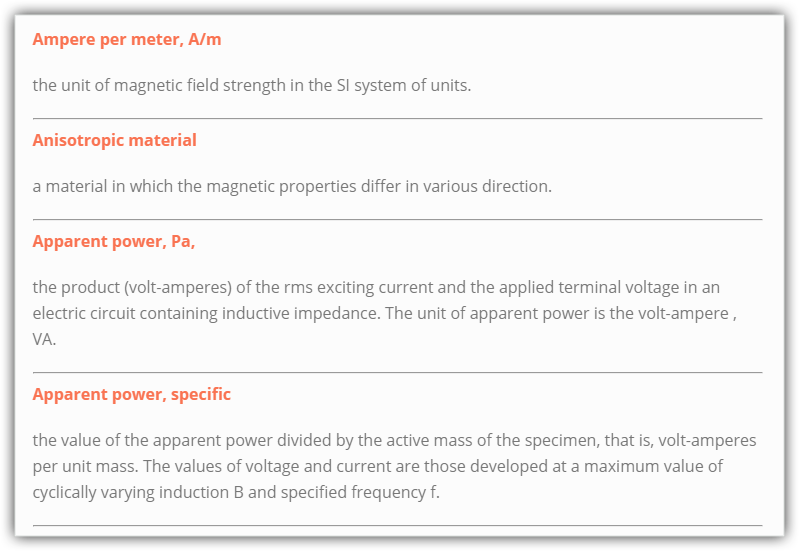-




 CONTINUETerminology
CONTINUETerminology
Ampere per meter, A/m
the unit of magnetic field strength in the SI system of units.
Anisotropic material
a material in which the magnetic properties differ in various direction.
Apparent power, Pa,
the product (volt-amperes) of the rms exciting current and the applied terminal voltage in an electric circuit containing inductive impedance. The unit of apparent power is the volt-ampere , VA.
Apparent power, specific
the value of the apparent power divided by the active mass of the specimen, that is, volt-amperes per unit mass. The values of voltage and current are those developed at a maximum value of cyclically varying induction B and specified frequency f.
Area, A
the geometric cross-sectional area of a magnetic path which is perpendicular to the direction of the induction.
Coercive field strength, Hc
the (dc) magnetic field strength required to restore the magnetic induction to zero after the material has been symmetrically cyclically magnetized.
Core, tape-wound
a magnetic component constructed by the spiral winding of strip material onto a suitable mandrel. The strip material usually has an insulating surface coating which reduces interlaminar eddy current losses in the finished core.
C-core
a spirally wound magnetic core that is formed to a desired rectangular shape before being cut into two C-shaped pieces.
Core loss, ac, (total), Pc
the active power (watts) expended in a magnetic circuit in which there is a cyclically alternating induction.
Density, δ
the ratio of mass to volume of a material.
Eddy current
an electric current developed in a material as a result of induced voltages developed in the material.
Electrical steel
a term used commercially to designate strip or sheet used in electrical applications.
Electrical steel, grain-oriented
a flat-rolled silicon-iron alloy usually containing approximately 3% silicon, having enhanced magnetic properties in the direction of rolling and normally used in transformer cores.
Exciting power, rms
the product of the ac rms exciting current and the rms voltage induced in the exciting (primary) winding on the magnetic core.
Note-This is the apparent volt-amperes required for the excitation of the magnetic core only. When the core has secondary winding, the induced primary voltage is obtained from the measured open-circuit secondary voltage multiplied by the appropriate turns ratio.
Flux path length
the distance along a flux loop.
Hysteresis loop, normal
a closed curve obtained with a ferromagnetic material by plotting corresponding dc values of magnetic induction(B) for ordinates and magnetic field strength (H) for abscissa when material is passing through a complete cycle between equal definite limits of either magnetic field strength, ±Hm, or magnetic induction, ±Bm.
Lamination factor,( space factor, stacking factor), S
is equal to ratio of the volume of magnetic material in a uniform laminated core to the overall geometric volume of the core.
Lamination surface insulation
the insulation between core laminations produced by a surface condition or layer either formed or applied for this purpose.
Magnetic flux, Φ
the product of the magnetic induction, B, and the area of a surface (or cross section), A, when the magnetic induction B is uniformly distributed and normal to the plane of the surface.
Magnetic induction, B
an alternate term for magnetic flux density.
Permeability, ac, rms, impedance, µz
the ratio of the measured peak value of magnetic induction, B, to the apparent magnetic field strength, Hz, calculated from the rms value of the total exciting current.
Note: The value of the current used to compute Hz is obtained by multiplying the value of rms exciting current by 1.414. this assumes that the total exciting current is magnetizing current and is sinusoidal.
Tesla, T
the SI unit of magnetic induction.
Resistivity, surface insulation (of single-strip specimen)
the effective resistivity of a single insulative layer tested between applied bare metal contacts and the base metal of the insulated test specimen.

- Eilor Ltd.
- +972 (8) 6358601
- eilor-office@eilor.co.il


